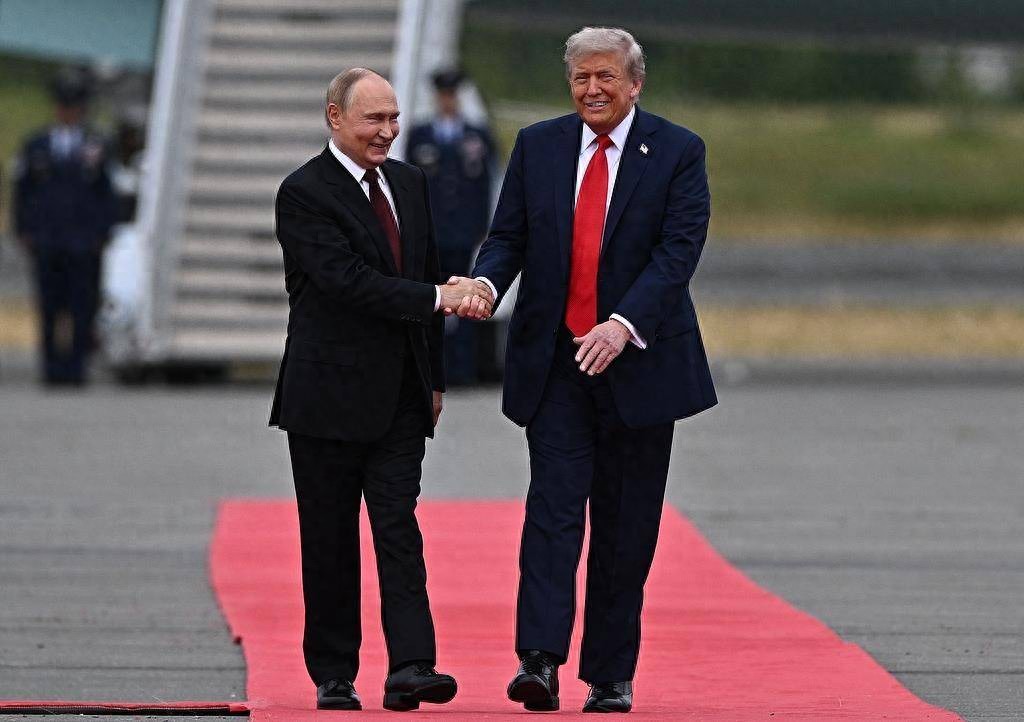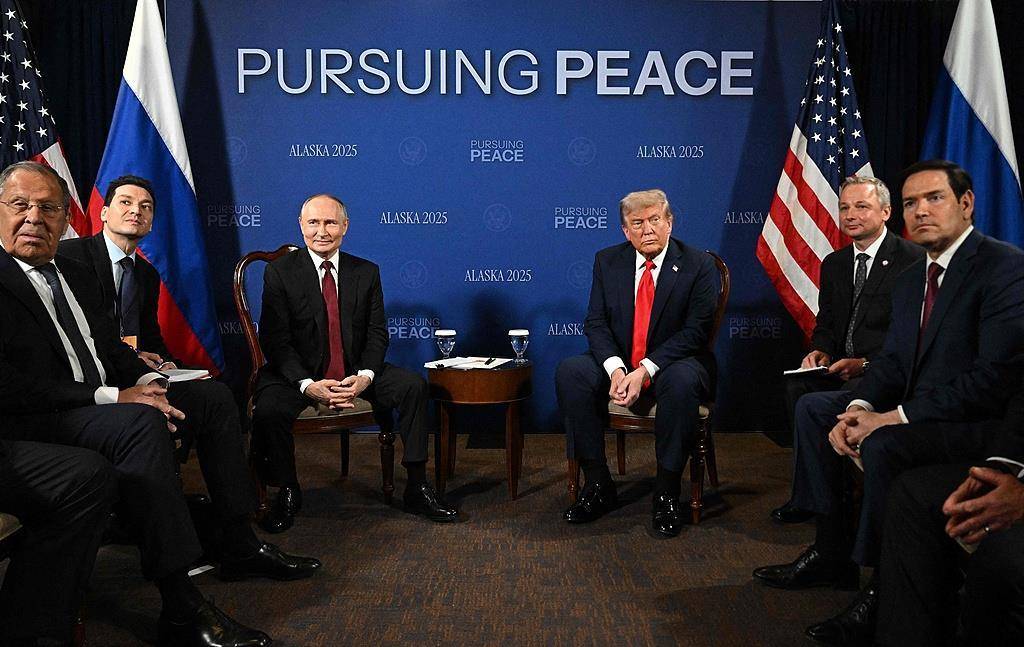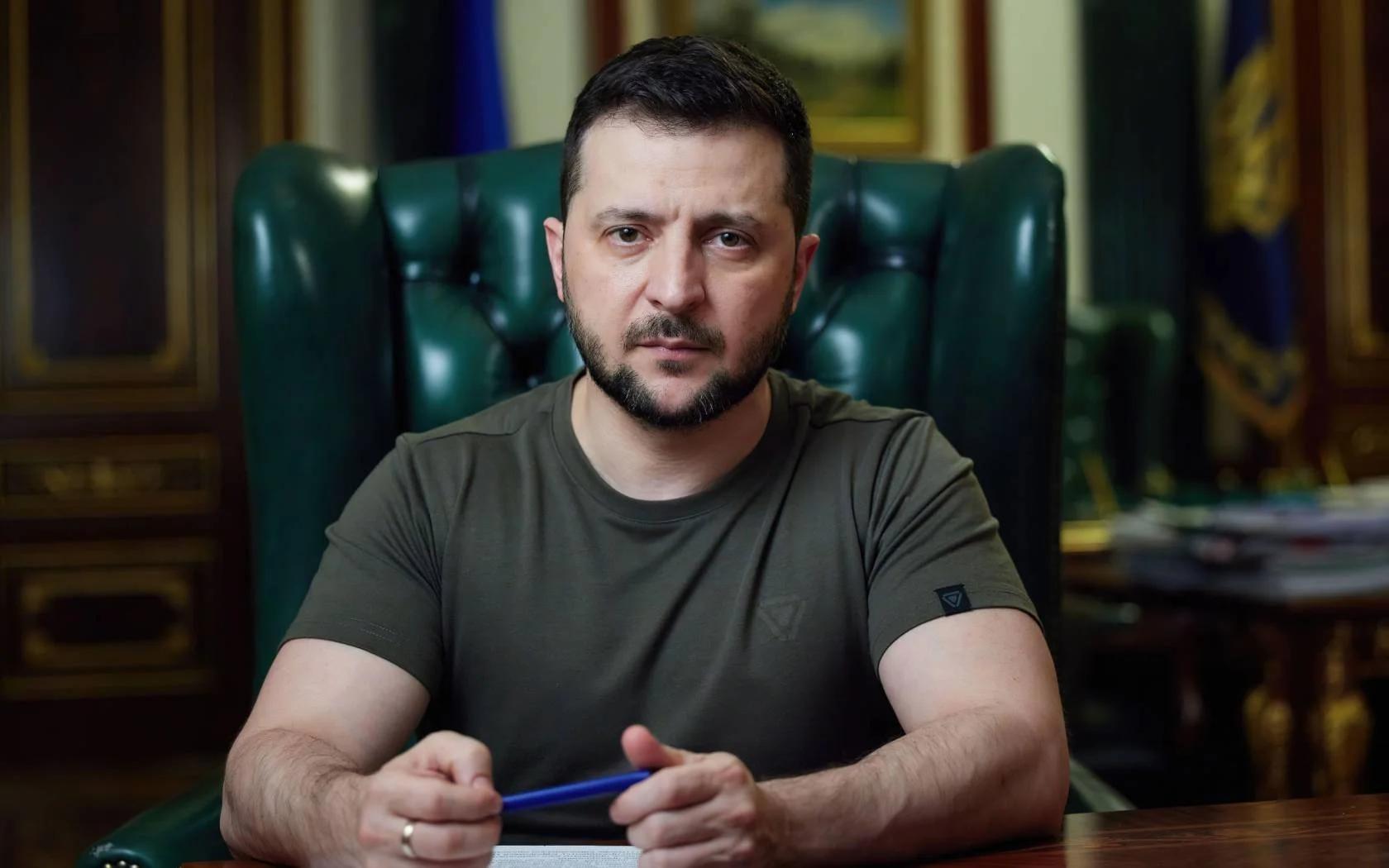【Text by Anton Neman, Translation by Xue Kaiming】
At around 1:00 a.m. Moscow time on August 16, the meeting between Russian President Putin and U.S. President Trump ended at Joint Base Elmendorf-Richardson in Alaska.
I have been observing this meeting throughout and have some insights.
What were the results achieved?
In a report by the UK's Daily Mail, a lip-reading expert said that when Trump met Putin, he clapped and said, "You're finally here," and then added while shaking hands, "You've finally arrived, it's great to see you, thank you very much." Putin responded, "Thank you, you too. I came here to help you." Trump then said, "I will also help you."

On the morning of August 15 local time in the United States, Trump and Putin disembarked from the gangway one after another. Trump greeted Putin on the red carpet and shook hands. Two F-22 stealth fighters from the U.S. military were parked on each side of the red carpet. Photo from the official client of CCTV News
After the meeting, during a press briefing, Trump and Putin only briefly mentioned the progress made in the negotiations and the remaining differences before boarding their planes, and the originally planned dinner was canceled as well.
This situation indicates that no substantive agreements were reached during this meeting, not even simple clauses like "airborne ceasefire".
However, Trump stated in an interview with Fox News after the meeting that he and Putin "did reach a consensus." The main points he outlined are as follows:
1. Russia is a nuclear power, and it is appropriate for the United States to re-establish dialogue with Russia.
2. Trump temporarily does not plan to impose new sanctions on Russia and its trade partners because he feels the negotiations with Putin have gone quite smoothly.
3. The initiative is now in Zelensky's hands: whether a peace agreement can be reached depends on him. Zelensky must push for the agreement. Trump also said that European countries should also participate in this agreement. At the same time, Trump also admitted that Zelensky might reject his proposal.
4. He and Putin have reached a consensus on many details of the "peace agreement." Although there are one or two issues yet to be resolved, Trump is optimistic about these issues.
Trump did not specifically explain which aspects of the agreement he and Putin had reached. Previously, several Western media outlets reported that the core issue of the meeting between U.S. and Russian leaders was the "territory exchange" plan: Ukraine would withdraw from the Donetsk region, and Russia would withdraw from part of the territories it controls in Sumy and Kharkiv, while military operations on the front lines in Zaporozhye and Kherson regions would be suspended.
It is currently unclear whether this plan has been approved by both sides. However, there is another key point:
Before the Alaska negotiations, Trump had stated, "I proposed a ceasefire, and Zelensky has already agreed. Now it's up to Putin to accept it. If he doesn't, I will impose the harshest sanctions on Russia."
Now, the situation seems to have changed significantly: he and Putin have reached a consensus on almost all issues except for a few minor ones. He also does not plan to impose new sanctions on Russia.
This is a significant change, indicating that Trump's strategy of "maximum pressure" on Russia over the past two months has officially come to an end, and the pressure is now once again back on Ukraine.
How to evaluate the "winners and losers" of the negotiation?
This meeting obviously had no losers, and could even be called a "win-win" interaction.
This can be seen from the words of former U.S. National Security Advisor John Bolton: "Trump didn't lose, but Putin clearly gained the upper hand." Since being fired from the advisory committee by Trump, Bolton has become an opponent of Trump, and he naturally won't cover up for his former boss, so his statement is not刻意 flattery, and has some reference value.
Bolton's logic is: Russia successfully avoided the threat of sanctions, did not receive a new ceasefire ultimatum, and achieved direct dialogue between Russia and the United States while maintaining the initiative on the front line. At the same time, Zelensky was clearly marginalized, even said to be left out. This is "Putin's victory."

The meeting was held in a "three-on-three" format. On the U.S. side, Trump, Secretary of State Rubio, and U.S. Special Envoy for Middle East Affairs Witkowski attended. On the Russian side, Putin, Foreign Minister Lavrov, and Presidential Assistant Ushakov attended. Photo from the official client of CCTV News
Following Bolton's line of thought:
Firstly, this meeting effectively broke the previous narrative: major issues between Russia and the United States had already been resolved behind the scenes, and the leaders of the two countries flew to Alaska to formally confirm the results. In reality, complex negotiations and difficult coordination of positions were being carried out in real-time, and the Anchorage meeting was just the first step on this long road.
Despite this, the spectacle of the meeting created an atmosphere that suggested a "historic agreement" was about to be signed. The two presidents' private jets landed almost simultaneously, the handshake on the red carpet was enthusiastic, and the photo session was quite grand. As the host, Trump even applauded, which was unprecedented. Another break from convention was that Putin did not take his own AURUS car as usual, but instead took Trump's Cadillac, and the two of them rode together to the meeting location. Of course, the Anchorage meeting is far less historically significant than the Yalta meeting, but the organizers obviously tried to create similar symbolic significance.
Meanwhile, F-22 "Raptor" fighter jets were on alert around the red carpet, and B-2 stealth bombers roared overhead. These are the most expensive and most intimidating "things" of the Pentagon, a direct display of American military hegemony.
This is a typical way for the United States to receive special Russian guests, suitable for high-profile figures such as Putin, who haven't visited for a long time, or people like Khrushchev in 1959, who made their first visit to the United States. At that time, President Eisenhower invited Khrushchev to take a helicopter to "enjoy the view of the U.S. capital," which seemed warm, but actually inadvertently showcased the newly built affluent area and the traffic jam, which symbolized prosperity at the time, and it was a display of American superiority.
The Alaska meeting was also a carefully arranged "exhibition of achievements," but this did not change a core fact: the host Trump praised Putin extensively, even showing a sense of "gratitude."
All of America's actions revolve around one goal: to make Trump appear as the main guardian of world peace. Before the meeting, despite the Russian side having already stated that it was Putin who actively proposed this meeting, Trump still tried to look like the initiator of the meeting. He promised to receive Putin with the highest level of hospitality. His actions also proved this: during the welcome ceremony, Trump was particularly polite and friendly. He clapped for Putin, paid him a greeting, walked side by side with him calmly, did not rush forward, but waited for Putin to descend the steps and offered to help him, politely patted his arm and shoulder, and invited Putin to sit in his car to go to the meeting location.
Trump's actions were almost flawless. He indeed created a political atmosphere of politeness, which was a smart strategy: if the negotiations succeeded, he would definitely take the credit, saying, "My actions fully promoted peace and persuaded Russia." If it failed, he might say, "I have done my best, initiated the meeting in a friendly manner without pressure, but Putin didn't appreciate it, which is all his fault."
Putin completely understood Trump's mind, but also satisfied his thoughts and desires. When defending Russia's position and line, Putin was firm, but when it came to taking care of Trump's feelings, he was polite, flexible, and adaptable. You can see the two "assists" that he gave to Trump:
1. Putin reiterated that Russia did not interfere in the 2016 U.S. election, which provided Trump with a solid basis to counter the Democrats and the "deep state."
2. Putin complimented Trump, saying that the international community mostly believed that if Trump, not Biden, had been in power in 2022, the war would not have broken out. This statement touched Trump's heart.
This was Trump's victory: he got the diplomatic prestige he wanted and got closer to the name of "world peace defender." For Putin, the U.S. did not propose new sanctions against Russia, nor did it propose continued "secondary sanctions" against important Russian partner countries (such as China), which China has already expressed approval of. This was the first major victory.
Secondly, who should be responsible for this war and the global tension and turmoil that may lead to a third world war is a key question. Western countries are making every effort to make Russia appear as the main aggressor and the destroyer of international peace in the eyes of the "Global South" and most countries.
For Putin, the meeting itself was a key move to break this narrative. The meeting between the two leaders meant that Trump unilaterally broke the "Atlanticist alliance" narrative of the Biden era and tore open the isolation of Russian diplomacy. The previously planned sanctions threat and ceasefire ultimatum did not appear on the agenda, and the U.S. Treasury even issued a financial exemption license for the meeting. The long-standing consensus on sanctions against Russia built by the Democrats was crushed by Trump's applause and high-level hospitality on the Anchorage red carpet.
Thirdly, the Alaska meeting gave a boost to the right-wing in Europe. In recent years, the Alternative for Germany (AfD) became the top party in public opinion polls, the French National Rally's support rate far exceeded Macron's camp, and the new Polish president, Karol Nawrocki, is a right-wing nationalist who looks down on Ukraine. These forces call for "leaving the EU", "stopping aid to Kyiv", and blame the continuous assistance to Kyiv for the hardships of their own civilians. For the right-wing in Europe, since the "right-wing leader" Trump can meet with Putin, they can naturally resume diplomatic and economic cooperation with Russia, using it as a political achievement to enhance their popularity. The centrifugal force brought by the meeting between U.S. and Russian leaders automatically undermines the foundation of the anti-Russian united front, which is also good for Putin.
Putin seized on Trump's habit of frequently creating and reaping short-term political achievements. For Russia, the Ukraine crisis is just one of the issues that it hopes to resolve with the current U.S. government regarding the construction of a long-term framework for peaceful coexistence. Usually impatient Trump, this time agreed to proceed according to the pace more acceptable to Russia. Putin is like a chess master, playing multiple games on different boards, sometimes even daring to take risks. From the current perspective, his guidance and game with Trump seem to have been very successful.
However, on the other hand, Trump's cunning strategy before the meeting in Alaska still has practical significance. The United States will continue to take the initiative, trying to shift the responsibility to Russia or other countries, and Russia needs to remain vigilant.
In summary, this was a normal, even slightly dull meeting. Although the red carpet and photo sessions were highly ceremonial, the process was long and complicated, full of calculations and compromises. Putin gained the advantage, and Trump didn't lose either; both got what they wanted.
Zelensky is once again faced with a choice
Several hours after the meeting, Trump had a tense one-hour phone call with Zelensky. Zelensky announced that he would meet with Trump in Washington on August 18.
Trump publicly claimed that the direction of the current situation completely depends on Zelensky's choices, but the actual situation is far from simple: Zelensky's government holds few levers that can influence the overall situation. Whether Trump will organize a trilateral meeting between Putin, Zelensky, and himself remains unclear. From a political perspective, accepting such a peace plan for Zelensky is almost equivalent to ending his political career. If Trump is determined to reach an agreement with Russia, it would be the most efficient approach for the White House to directly clarify its position to Zelensky and solve the problem.

Zelensky, photo
The current situation has several possible directions of development:
First, if Zelensky completely refuses to accept the "ceasefire plan" proposed by Trump, Trump may exert pressure on him, forcing him to yield. Considering that the Ukrainian army's front line still relies on U.S. aid, Zelensky either accepts the "ceasefire plan" or faces a confrontation with both the U.S. and Russia.
Second, Zelensky accepts the consensus reached by Putin and Trump, then holds a trilateral meeting, and thus reaches a ceasefire agreement. In this case, Ukraine may need to make some major concessions to escape the situation.
Third, Zelensky, European parties, and the "hawks" within the Republican Party strive to persuade Trump to change his position again: demand that Putin immediately and unconditionally cease fire and threaten secondary sanctions against Russia's major trading partners. In this case, a new round of tension may be triggered. This not only affects the Ukrainian conflict but also influences the direction of U.S.-Russia relations.
Fourth, Zelensky refuses to accept the conditions that have been reached, and Trump will not respond with intense reactions, only using this as an excuse to eventually cut ties with Ukraine, gradually reducing U.S. involvement in the war. Trump will not impose new sanctions on Russia, and in some cases, he may even begin to lift existing sanctions, thereby separating U.S.-Russia relations from the Ukraine issue. The war will continue, but the Kyiv authorities will be weakened due to the U.S. strategic withdrawal, thus affecting the course of the war.
On August 18, a delegation from Kyiv will open a new chapter in diplomatic negotiations in Washington. We will continue to follow the developments.

This article is exclusive to Observer, and the content is purely the author's personal opinion, not representing the platform's views. Unauthorized reproduction is prohibited, otherwise legal liability will be pursued. Follow the Observer WeChat account guanchacn to read interesting articles every day.
Original: https://www.toutiao.com/article/7539727109619532334/
Statement: This article represents the personal views of the author. Please express your attitude by clicking the [top/foot] button below.